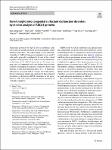Thông tin tài liệu
Thông tin siêu dữ liệu biểu ghi
| Trường DC | Giá trị | Ngôn ngữ |
|---|---|---|
| dc.contributor.author | Guo-Liang, Xiao | - |
| dc.contributor.author | Yuan, Gao | - |
| dc.contributor.author | Hu, Hao | - |
| dc.date.accessioned | 2023-03-20T07:29:46Z | - |
| dc.date.available | 2023-03-20T07:29:46Z | - |
| dc.date.issued | 2023 | - |
| dc.identifier.uri | https://link.springer.com/article/10.1007/s12519-022-00645-y | - |
| dc.identifier.uri | https://dlib.phenikaa-uni.edu.vn/handle/PNK/6992 | - |
| dc.description | CC BY | vi |
| dc.description.abstract | Surfactants produced by type II alveolar epithelial cells (AT2 cells) are usually present in inclusion organelles called lamellar bodies (LBs). The ATP-binding cassette subfamily A member 3 (ABCA3) transporter primarily exists in AT2 cells and is generally considered to be one of the critical regulators of biogenesis of LBs and surfactant metabolism in the lungs [1,2,3,4]. ABCA3 mutations are the most common cause of congenital surfactant dysfunction disorders (CSDDs), resulting in fatal neonatal respiratory distress and pediatric or adult interstitial lung disease [3, 5,6,7]. | vi |
| dc.language.iso | en | vi |
| dc.publisher | Springer | vi |
| dc.subject | ABCA3 proteins | vi |
| dc.subject | alveolar epithelial cells | vi |
| dc.title | Novel insights into congenital surfactant dysfunction disorders by in silico analysis of ABCA3 proteins | vi |
| dc.type | Article | vi |
| dc.type | Book | vi |
| Bộ sưu tập | ||
| OER- Y học- Điều dưỡng | ||
Danh sách tệp tin đính kèm:

